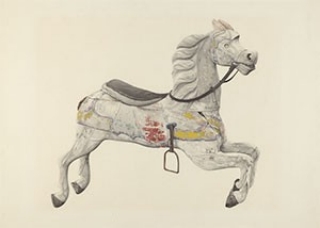National Gallery of Art, Washington
Conceived as an effort to identify and preserve a national, ancestral aesthetic, the Index of American Design comprises 18,257 watercolor renderings of American folk and decorative arts objects from the colonial period through 1900. A Federal Art Project (FAP) work-relief program during the Depression—and executed between 1935 and 1942 by approximately four hundred artists under the direction of Holger Cahill—this visual archive of a “usable past” documented woodcarvings, textiles, whirligigs, weathervanes, and other objects from thirty-four states in six regions of the US: the West Coast, Rocky Mountains, Midwest, South, New England, and New York. Objects depicted came from a variety of sources: public institutions, local museums, large private collections, and more modest homes. The Index became a source of inspiration for artists and sought to sustain a distinctively American visual lineage, especially with regard to the generation of new industrial American design.
In addition to Cahill, the primary advocates for the project were scholar Constance Rourke, who served as editor, and gallerist Edith Halpert, who collected and sold American folk art, believing it was the aesthetic antecedent of American modernism. At her Downtown Gallery, Halpert also represented modern artists like Stuart Davis and Charles Sheeler, whose work she felt demonstrated this visual affinity. By contrast, most watercolorists depicting these objects for the Index had been commercial artists and illustrators, and their renderings are primarily distinguished by a high degree of technical proficiency. They took between two and ten weeks to produce meticulous images that Cahill considered more successful than photographs at capturing the “essential character” of their subjects.
As the culmination of the project, the watercolor renderings were meant to be organized by subject, published in portfolios, and widely disseminated. Although only one portfolio dedicated to Hispano work was produced, more than fifty contemporary exhibitions of these works appeared in museums, department stores, and Federal Art Centers around the country. It was through these popular exhibitions that the Index of American Design, and the folk art it depicted, became known to the American public. By the early 1940s, with unemployment significantly easing, the project was terminated, and in 1943, at Cahill’s urging, the newly founded National Gallery of Art became the permanent repository for the Index.
Aleesa Pitchamarn Alexander
Clayton, Virginia Tuttle, ed. Drawing on America’s Past: Folk Art, Modernism, and the Index of American Design. Washington, DC: National Gallery of Art, 2002.
